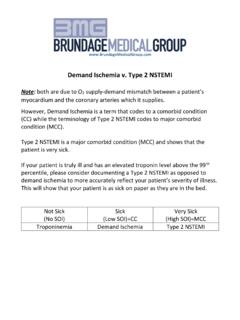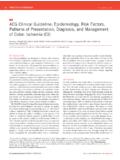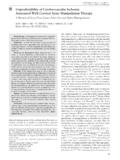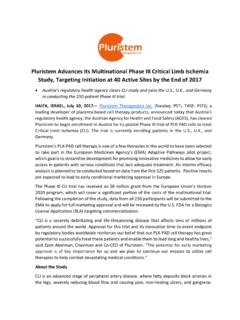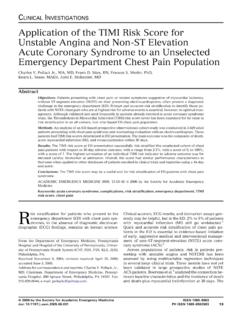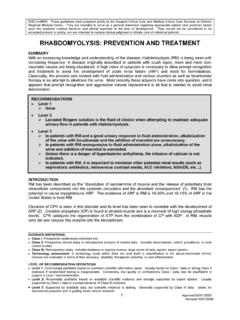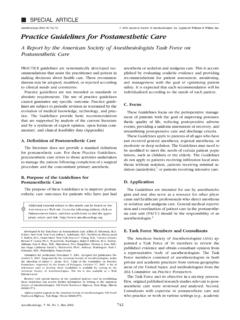Transcription of Step 1: Rhythm Step +2: Conclusion (1 sentence) Ischemia
1 Before you startCheck name, date, time, paperspeed (25 mm/sec), scale (10 mm/mV). Continue with the 7+2 1: RhythmSinus Rhythm (SR) (60-100/min): every P wave is followed by a QRSN arrow QRS tachycardias (QRS<120ms; >100/min) are always supraventricular tachycardias (SVT):Sinustachycardia: sinusrhythm > 100/min. Eg. Fever / Psych. stress / CardiomyopathyAtrial fibrillation (AFIB): irregular Permanent = chronic. Persisting = recurring after chemical / electrical cardioversion Paroxysmal = comes and goes spontaneously: SR AFIB SR Atrial flutter: flutter waves on baseline. Often regular 300 / min with a 2:1, 3:1 or 4:1 block. AVNRT: AV nodal re-entry tachycardia. Regular, 180-250 / min. P in QRS complex (resulting in RsR in V1), often young patients and paroxysmal. Valsalva / carotid massage / adenosine can terminate episode. Wide complex tachycardias (QRS>120ms): possible risk of sudden death, always consult with cardiologist.
2 Ventricular tachycardia. Arguments for VT (Brugada criteria): fusion (sudden narrow beat), absence of RS precordialy, RS > 100ms, AV dissociation, atypical LBBB. Typically in older patient with previous MI. Unconscious? proceed to immediate defibrillation. SVT with aberrancy. Typical in younger patient. How was the QRS duration / shape on a previous non-tachycardic ECG?Ventricular fibrillation = no QRS-complexes, but chaotic ECG-pattern, like noise mechanical cardiac arrest resuscitate. If patient is conscious it probably is (<60/min). Consider stop / reduce beta-blocker / digoxin / Ca-antagonist. Asymptomatic sinusbradycardia with a normal blood pressure in general doesn t require treatment. 1st degree AV-block: prolonged PQ-interval (> 200ms) 2nd degree AV-block type I (Wenkebach): PQ interval increases until 1 QRS complex is blocked. Good prognosis.
3 2nd degree AV-block type II (Mobitz): PQ interval is normal, but not every P wave is followed by QRS. Requires pacemaker. 3rd degree AV-block = complete block. AV dissociation: no relationship between P waves and QRS. Requires pacemaker. Ventriculair escape Rhythm : wide complex Rhythm < 40/min; dangerous. Consult cardiologist. Ischemia ? Severe electrolyte shift?Step 2: Heart rateCount the number of large grids between two QRS complexes: 1 box in between = 300/min, 2=150/min - 100 - 75 - 60 - 50 - 40. Or use methods at the bottom of this 3: Conduction intervals (PQ, QRS, QT)Normal: PQ <200ms (5 small squares), QRS < 120ms(3 squares), QTc < 450 ms, < 460 ms, preferably measured in lead II or lead > 200ms = AV block (above)PQ < 120ms + delta-wave = Wolff-Parkinson-White syndrome (WPW), risk of a circus movement tachycardias (= AVRT: AV re-entry tachycardia)QRS > 120ms = wide QRS complex, check V1: Left Bundle Branch Block (LBBB) Latest activity towards the left, away from V1, so QRS ends negatively in V1.
4 New LBBB? Consider Ischemia . Right Bundle Branch Block (RBBB) RsR (rabbit ear) latest activity rightwards, (on average) positive in V1 Intraventricular conduction delay= if it s not LBBB nor RBBB QTc > 450ms: consider: hypokalemia, post myocardial infarction, long QT syndrome, medication (full list on ). Risk of torsade de pointes deteriorating into ventricular fibrillation (risk increases especially >500ms).Step 4: Heart axisHeart axis: vector of the average electrical activity. Normal between 30 and +90 . Expecially axis deviation compared to previous ECG is relevant. Normal hart axis: QRS positive in II and AVFLeft axis: AVF and II negative. Eg. left anterior fascicular block (LAFB), axis. I negative, AVF positive. Eg. pulmonary embolism, 5: P wave morphologyNormal P wave: positive in I and II, bifasic in V1, similar shape in every consider ectopic atrial Rhythm .
5 Left atrial enlargement: terminal negative part in V1 > 1mm2. mitral-regurgitation. Right atrial enlargement P> high in II, III, AVF and / or P> in V1. COPD Step 6: QRS morphologyPathologic Q waves? Old myocardial infarction (see Ischemia )Left ventricular hypertrophy (LVH): R in V5/V6 + S in V1 > 35 mm. Seen in hypertension, aortic valve stenosis. R wave progression: R increases V1-V5. R>S beyond V3 Microvoltages (<5mm in extremity leads): cardiomyopathy, tamponade, obesity, pericarditisWide QRS complex (QRS > 120ms): see Step 3 Step 7: ST morphologyST elevation: consider Ischemia , pericarditis, LVH, benign ST elevation, early repolarisation ST depression: can be reciprocal in ischemie, strain pattern in LVH, digoxin intoxicationNegative T wave: (not in the same direction as the QRS complex) consider (subendocardial) Ischemia , LVHFlat T wave (< mm): aspecificStep +1: Compare with previous ECGNew LBBB?
6 Change in axis?. New pathologic Q waves? Reduced R wave height?Step +2: Conclusion (1 sentence) Example: Sinustachycardia with ST elevation in the chest leads with a trifascicular block consistent with an acute anterior myocardial infarctionIschemiaAcute myocardial infarction (AMI): symptoms (chest pain, vagal response), ECG consistent with transmural Ischemia (ST elevations (+reciprocal depressions), new LBBB, sometimes already pathologic Q waves), sometimes already elevated cardiac markers for AMI (Troponin / CKMB). Time is muscle . If you suspect AMI consult cardiologist immediately (< 5 min.)ST-elevation points at the infarcted area: Anterior: V1-V4. Coronary territory: LAD. sometimes tachycardia Inferior: II, III, AVF. Coronary: 80% RCA (bradycardia, elevation III>II; depression in I and / or AVL), otherwise RCX (in 20%). Right ventricular MI: ST in V1 and V4R.
7 IV fluids if hypotensive Posterior: high R wave and ST depressie in V1-V3 Lateral: elevation in I, AVL, V6. Coronary: LAD (Diagonal branch) Left main: diffuse ST depression with ST elevation in AVR. Very high risk of cardiogenic shockReciprocal depression: depression in reciprocal territory ( ST depression in II, III, AVF during anterior MI). IPL-infarction: inferior-posterior-lateral. They frequently come togetherPathologic Q-wave (any Q in V1-V3 or Q width > 30ms in I, II, AVL, V4-V6; minimal in 2 contiguous leads, minimal depth 1 mm): previous MI. Leads III and AVR may have a Q wave, which is (ventricular premature beat, VES: ventricular extrasystole, PVC, Premature ventr. contr.). QRS > 120ms. Seen in 50% of healthy men. Increased risk of arrhythmias if: complex form, very frequent occurence (> 30 / hour) or R on T. Consider: Ischemia ? Previous MI?
8 Cardiomyopathy?PAC (premature atrial contraction, AES): abnormal P wave, mostly narrow (normal) QRS complexPericarditis: ST elevation in all leads. PTA depression in II (between the end of the P wave and the beginning of Q wave)Hyperkalemia: tall T waves. QRS wide, flat PHypokalemia: QT prolongs, U wave, torsadeHypocalcemia: ST prolongs, normal THypercalcemia: QT short, high TDigoxin-intoxication: sagging ST depressionsPulmonary embolism: sinustachycardia, deep S in I, Q wave and negative T in III, negative T V1-V3, right axis, sometimes RBBBC hest lead positioning: V1= 4th intercostal space right (IC4R), V2=IC4L, V3=between V2 en V4, V4=IC5 in midclavicular line, V5=between V4 and V6, V6= same height as V4 in axillary line. To register V4R, use V3 in the right mid-clavicular educational purposes only. May contain errors. Read for fuller explanation.
9 Is part of the Cardionetworks Foundation. Version: 12/2010, intervalPQ intervalQRS durationBaselineST-segmentST-elevationHo w to measure ST elevation?Heart rate = 10 times number of QRS complexes within these 15 cm ( = 6 seconds x 25 mm/sec)1st R300150100756050/minHeartrate: measure 2 cardiac cycles200120866755 Maximal QTc per given heart rate: what QT value at what heart rate results in a QTc of 450ms?50/min:QT 493ms60/min:QT 450ms70/min:QT 417ms80/min:QT 390ms90/min: QT 367ms100/min: QT 349msQTc=QTRR(in sec)Normal sinus Rhythm . Every P wave is followed by aQRS complex. Heart rate between 60-100 Premature Beat (VPB)RBBB, Right Bundle Branch BlockLBBB, Left Bundle Branch Block(Wol -Par kinson-White).Atrium utter met 6:1 brilleren met hoge re-entry tachycardieVentricular tachycardiaAcute anterior MI. ST-elevation in V1-V5, I and AVL. Reciprocal ST-depression in II, III and infero-posterior MI.
10 ST-elevation in II, IIIand AVF. Reciprocal ST-depression in I, AVL, V1-V5 Color scheme to facilitate MI localisation. The colors mark contiguous leads. Example: (see above): ST elevation in II, III, AVF acute inferior MIPathologic Q wave, sign of a previous MIDelta wave and short PQ interval in WPW-syndrome I LateralII InferioraVL LateralaVR Left MainaVF InferiorV1 SeptalV2 SeptalV3 AnteriorV6 LateralV5 LateralV4 AnteriorIII InferiorLeft Ventricular Hypertrophy (LVH, R in V5/V6 + S in V1 > 35 mm)AV nodal re-entry tachycardia(AVNRT)Atrial tachycardia(single focus)AV re-entry tachycardia(re-entry throught accessory bundleas in WPW)Atrial utter(often around tricuspid valve annulus)Atrial brillationSupraventricular tachycardias ( cherchez le P )large square = 5 mm = secsmall square = 1 mm = secSRretrograde P wave in QRSretrograde P between QRSdifferent P wave morphology
